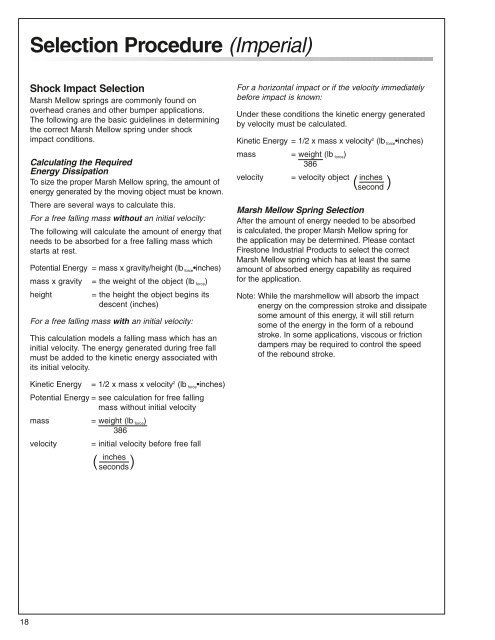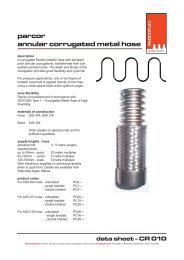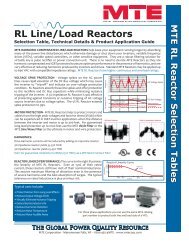Marsh Mellow - Ferret
Marsh Mellow - Ferret
Marsh Mellow - Ferret
Create successful ePaper yourself
Turn your PDF publications into a flip-book with our unique Google optimized e-Paper software.
18<br />
Selection Procedure (Imperial)<br />
Shock Impact Selection<br />
<strong>Marsh</strong> <strong>Mellow</strong> springs are commonly found on<br />
overhead cranes and other bumper applications.<br />
The following are the basic guidelines in determining<br />
the correct <strong>Marsh</strong> <strong>Mellow</strong> spring under shock<br />
impact conditions.<br />
Calculating the Required<br />
Energy Dissipation<br />
To size the proper <strong>Marsh</strong> <strong>Mellow</strong> spring, the amount of<br />
energy generated by the moving object must be known.<br />
There are several ways to calculate this.<br />
For a free falling mass without an initial velocity:<br />
The following will calculate the amount of energy that<br />
needs to be absorbed for a free falling mass which<br />
starts at rest.<br />
Potential Energy = mass x gravity/height (lb force•inches)<br />
mass x gravity = the weight of the object (lb force)<br />
height = the height the object begins its<br />
descent (inches)<br />
For a free falling mass with an initial velocity:<br />
This calculation models a falling mass which has an<br />
initial velocity. The energy generated during free fall<br />
must be added to the kinetic energy associated with<br />
its initial velocity.<br />
Kinetic Energy = 1/2 x mass x velocity2 (lb force•inches)<br />
Potential Energy = see calculation for free falling<br />
mass without initial velocity<br />
mass = weight (lb force)<br />
386<br />
velocity = initial velocity before free fall<br />
inches<br />
( seconds)<br />
For a horizontal impact or if the velocity immediately<br />
before impact is known:<br />
Under these conditions the kinetic energy generated<br />
by velocity must be calculated.<br />
Kinetic Energy = 1/2 x mass x velocity2 (lb force•inches)<br />
mass = weight (lb force)<br />
386<br />
velocity = velocity object inches<br />
(<br />
second )<br />
<strong>Marsh</strong> <strong>Mellow</strong> Spring Selection<br />
After the amount of energy needed to be absorbed<br />
is calculated, the proper <strong>Marsh</strong> <strong>Mellow</strong> spring for<br />
the application may be determined. Please contact<br />
Firestone Industrial Products to select the correct<br />
<strong>Marsh</strong> <strong>Mellow</strong> spring which has at least the same<br />
amount of absorbed energy capability as required<br />
for the application.<br />
Note: While the marshmellow will absorb the impact<br />
energy on the compression stroke and dissipate<br />
some amount of this energy, it will still return<br />
some of the energy in the form of a rebound<br />
stroke. In some applications, viscous or friction<br />
dampers may be required to control the speed<br />
of the rebound stroke.
















